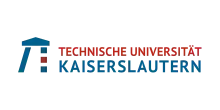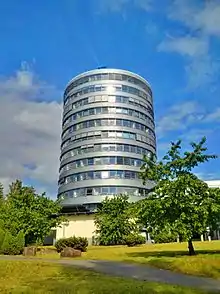Technical University of Kaiserslautern
Technical University of Kaiserslautern (German: Technische Universität Kaiserslautern, also known as TU Kaiserslautern or TUK) was a public research university in Kaiserslautern, Germany.
Technische Universität Kaiserslautern | |
 | |
| Type | Public research university |
|---|---|
| Active | 1970[1]–January 1, 2023 |
| Budget | € 208.7 million[2] |
| Chancellor | Stefan Lorenz[3] |
| President | Arnd Poetzsch-Heffter[3] |
Academic staff | 2,418[4] |
Administrative staff | 233[4] |
| Students | 14,869[4] |
| Location | , , Germany |
| Website | www.uni-kl.de |
On January 1, 2023, the university was merged with the Landau campus of the University of Koblenz-Landau into the University of Kaiserslautern-Landau, or Rheinland-Pfälzische Technische Universität Kaiserslautern-Landau (RPTU) in German.
There are numerous institutes around the university, including two Fraunhofer Institutes (IESE and ITWM), the Max Planck Institute for Software Systems (MPI SWS), the German Research Center for Artificial Intelligence (DFKI), the Institute for Composite Materials (IVW) and the Institute for Surface and Thin Film Analysis (IFOS), all of which cooperate closely with the university.[5]
TU Kaiserslautern was organized into 12 faculties.[6] Approximately 14,869 students are enrolled at the moment.[7] The TU Kaiserslautern is part of the Software-Cluster along with the Technische Universität Darmstadt, the Karlsruhe Institute of Technology and Saarland University. The Software-Cluster won the German government's Spitzencluster competition, the equivalence to the German Universities Excellence Initiative for clusters.[8][9]
History
The University of Kaiserslautern was founded on 13 July 1970[1] by the state of Rhineland-Palatinate as a constituent member of the twin University of Trier-Kaiserslautern. 191 students matriculated in the winter semester 1970/1971 in the Faculties of Mathematics, Physics and Technology. In 1972 the Faculties of Chemistry and Biology were founded. At the same time the Faculty of Technology was split into the Faculties of Mechanical Engineering and Electrotechnology, Architecture/Regional and Environmental Planning/Educational Sciences.
In 1975 the twin university was split into two independent universities: University of Trier and the University of Kaiserslautern.[1] The Faculties, which were established successively, continuously strengthened the university's scientific character: Electrotechnology (1975), later Electrical and Computer Engineering (1999), Computer Science (1975), Engineering (1975), later Mechanical and Process Engineering (1995), Architecture/Regional and Environmental Planning/Civil Engineering (1978–1979) and Social and Economic Studies (1985). The official name of the university is Technische Universität Kaiserslautern according to the new law on Higher Education of the Land Rhineland Palatinate which came into force on 1 September 2003.[1]
On January 1, 2023, the university was merged with the Landau campus of the University of Koblenz-Landau to form the University of Kaiserslautern-Landau.
Organization

Faculties
These are the 12 faculties in which the university is divided:[6]
Research fields
The integration of engineering and natural sciences is one of TU Kaiserslautern's main objectives. The state of Rhineland-Palatinate funds several research initiatives at the University of Kaiserlautern:
- Advanced Materials Engineering (AME)[22]
- Complex Data Analysis in Life and Biotechnology (BioComp)[23]
- State Research Center for Optics and Material Sciences (OPTIMAS)
- Artificial Intelligence Enhanced Cognition and Learning[24]
- Mathematics applied to real-world challenges (MathApp)[25]
- Nanostructured Catalysts (NanoKat)[26]
- Symbolic Tools in Mathematics and their Application (SymbTools)[27]
- Center for Commercial Vehicle Technology (ZNT)[28]
Sports facilities
The university has a Sports Hall in building 28 which includes facilities for badminton, gym, table tennis, etc. Running, hockey, basketball and football can be played in the accompanying sports grounds.[29]
Associations and student initiatives
- Leo-Club Kaiserslautern – a youth organisation of Lions Clubs International.
- Karat Racing Team e.V. – Formula Student team.[31]
- Bonding studentinitiative e.V.
- AEGEE-Kaiserslautern[32] – local group of the European Students' Forum, fostering intercultural exchange and cross-border communication and striving for European integration.
- STEP e.V. – a non-profit organization to support foreign exchange of the Faculty of Business Studies and Economics[33]
- EMECS-thon – an embedded systems marathon open to all students from EMECS consortial universities and partner universities, where the participating teams have 48 hours to develop an embedded systems project from scratch. The event is carried out simultaneously in the universities of the EMECS consortium, as well as in several partner universities each year.[34]
- Muslimische Studierenden Gruppe Kaiserslautern – A non-profit group of University of Kaiserslautern Muslim students.
References
- "History".
- "Zahlen und Fakten" (PDF). Technische Universität Kaiserslautern. 2015. Archived from the original (PDF) on 24 September 2016. Retrieved 31 August 2016.
- "University Leadership".
- "Facts and Figures".
- "Institutes and Research Centres". www.uni-kl.de. Retrieved 8 October 2019.
- "Faculties".
- "TU Kaiserslautern".
- Internetredaktion, Redaktion: BMBF LS5. "Software-Cluster – BMBF Spitzencluster". Bundesministerium für Bildung und Forschung – BMBF Spitzencluster (in German). Retrieved 8 October 2019.
- "Software-Cluster | Europas leistungsstärkstes Netzwerk von Unternehmen, Ausbildungs- und Forschungseinrichtungen im Bereich der Software-Entwicklung" (in German). Retrieved 8 October 2019.
- "Fachbereich Architektur – TU Kaiserslautern". www.architektur.uni-kl.de (in German). Retrieved 10 February 2023.
- "Department of Biology – TU Kaiserslautern". www.bio.uni-kl.de. Retrieved 10 February 2023.
- Faculty of Civil Engineering. Retrieved October 14, 2019.
- "Department of Chemistry – TU Kaiserslautern". www.chemie.uni-kl.de. Retrieved 10 February 2023.
- "Department of Electrical and Computer Engineering – TU Kaiserslautern". www.eit.uni-kl.de. Retrieved 10 February 2023.
- "Dept. of Computer Sci.: Computer Science in Kaiserslautern". www.informatik.uni-kl.de. Retrieved 10 February 2023.
- "Mechanical and Process Engineering – TU Kaiserslautern". www.mv.uni-kl.de. Retrieved 10 February 2023.
- "Home – TU Kaiserslautern". www.mathematik.uni-kl.de. Retrieved 10 February 2023.
- "Department of Physics – TU Kaiserslautern". www.physik.uni-kl.de. Retrieved 10 February 2023.
- "Department of Spatial- and Environmental Planning – TU Kaiserslautern". www.ru.uni-kl.de. Retrieved 10 February 2023.
- "Home – TU Kaiserslautern". www.sowi.uni-kl.de. Retrieved 10 February 2023.
- "Startseite – TU Kaiserslautern". international.wiwi.uni-kl.de. Retrieved 10 February 2023.
- "AME – RPTU Rheinland Pfälzische-Technische Universität Kaiserslautern-Landau". rptu.de. Retrieved 10 February 2023.
- "BioComp".
- "AI Enhanced Cognition and Learning – RPTU Rheinland Pfälzische-Technische Universität Kaiserslautern-Landau". rptu.de. Retrieved 10 February 2023.
- "MathApp".
- "Nanostructured Catalysts (NanoKat)".
- "SymbTools – RPTU Rheinland Pfälzische-Technische Universität Kaiserslautern-Landau". rptu.de. Retrieved 10 February 2023.
- "ZNT – RPTU Rheinland Pfälzische-Technische Universität Kaiserslautern-Landau". rptu.de. Retrieved 10 February 2023.
- "University sports facilities".
- "Student Initiatives".
- "KaRaT – Kaiserslautern Racing Team e.V." Retrieved 10 February 2023.
- AEGEE Kaiserslautern
- "Home – TU Kaiserslautern". step.wiwi.uni-kl.de. Retrieved 10 February 2023.
- "EMECS-thon".